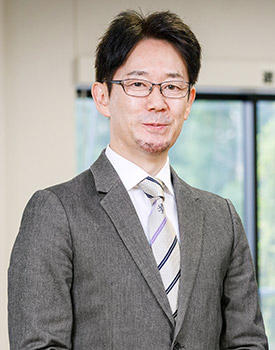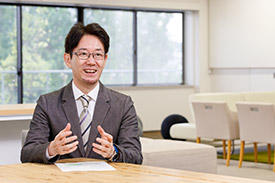

12/23/2019

In October 2019, Professor Shin-ichi Orimo became the third director of the Advanced Institute for Materials Research (AIMR) at Tohoku University in its 12-year history. He succeeded Professor Motoko Kotani, who had been director of the AIMR since 2012. They are big shoes to fill. “Under her guidance, researchers at the AIMR produced many outstanding results,” Orimo notes. “The excellent quality of this research brought us worldwide recognition.”
But Orimo is ideally positioned to assume the directorship of the AIMR. For a start, he has enjoyed a long relationship with the AIMR. His laboratory at the Institute of Materials Research, which is also at Tohoku University and just a short stroll from the AIMR, is seeking to research and develop hydrogen functional materials for energy devices such as fuel cells and all-solid-state secondary batteries. Over the years, his team has collaborated extensively with AIMR researchers. “As the leader of the Device/System Group at the AIMR, I have participated in many joint research projects and have strengthened collaboration with others on our teams,” Orimo says.
Orimo is keen to continue the interdisciplinary emphasis that the AIMR has been focusing on, namely the two-way interaction between mathematics and materials science. “This approach has more than proved its worth,” he says. “My aim is to further advance the collaboration between mathematics and materials science and to link this to the creation of new materials.”
Orimo is very conscious of the valuable insights that mathematics can bring to materials science through his own research topic. “Molecular dynamics calculations are extensively used to investigate ion mobility in materials,” he explains. “At the AIMR, we are using a mathematical perspective to identify structural characteristics with a focus on mobility randomness to obtain a more fundamental understanding.” This is just one example of the symbiotic relationship between the two fields: “We are really interested in two-way research, namely the application of mathematics to materials, and materials to mathematics.”
One practical link being forged between mathematics and materials science is the recent appointment of a renowned mathematician, Professor Hiroshi Suito, as deputy director of the AIMR. He is a leader at the Mathematical Science Group of the AIMR.
Another conduit is the establishment of three Advanced Target Projects (ATPs) that will address the control of local structure in topological functional materials; the integrated control of bond variation and its time evolution; and improving self-organization technology and controlling biological responses. “These projects not only build on the knowledge and methods gained in AIMR’s conventional research, but they also go further by employing mathematical techniques that are easier to apply to material creation,” Orimo says. He notes that the three ATPs respectively address phenomena on the micro, meso and macro scales. “Our ultimate goal is to create materials based on a complete understanding and control of atoms and molecules — the smallest units for materials,” Orimo says. “To reach this goal, the ATPs aim to create materials that express new functions by connecting our understanding and ability to precisely control atoms and molecules to phenomena on the meso and macro scales.”
Another major emphasis of the AIMR has been the adoption of a global outlook through strengthening ties with overseas researchers and institutes. The institute has established three joint laboratories with overseas institutions: one with the University of Cambridge in the UK with a focus on non-equilibrium materials and computational materials science, another with the University of Chicago in the US that specializes in spintronics, and a third with Tsinghua University in China focusing on topological materials. Orimo intends to continue to pursue international collaboration. “I hope to develop exchange relationships with overseas universities and research institutions, especially those in Switzerland and France,” he says.

The AIMR has an excellent track record of applying research outcomes to industrially relevant problems. Orimo is no stranger to collaboration with industry. His research team has collaborated with a wide range of companies, including those in the materials, electricity and vehicle industries. And he is working on creating a research platform between industry and academia. “I want to deepen cooperation with industry by further strengthening ties with university–industry collaborative organizations at Tohoku University,” he comments. “Collaborating with industry is critical for creating materials that contribute to society.”
Speaking of his vision for his directorship, Orimo refers to ‘three Rs’: Relief, Research and Recognition. The first ‘R‘, Relief, refers to the holistic welfare of everyone at the institute, including their physical safety and mental well-being. The second ‘R’ is for research, which must stay as close to the frontiers of current knowledge as possible. “Being at the edge of the research front means being at a cliff edge at the same time,” Orimo explains. “It is crucial that we always stay alert to that fact.” Finally, the third ‘R’ is recognition, which involves actively publicizing research results, so that the AIMR gains an even higher profile both in Japan and abroad.
“My vision is to lead the AIMR to the next stage as the world’s leading institute for materials science by strengthening collaboration between materials science and mathematics, while advancing the discovery and development of new materials through the utilization of advanced measurement technologies,” explains Orimo. “In light of the problems we face today, I hope to provide various solutions in collaboration with our members,” he adds.